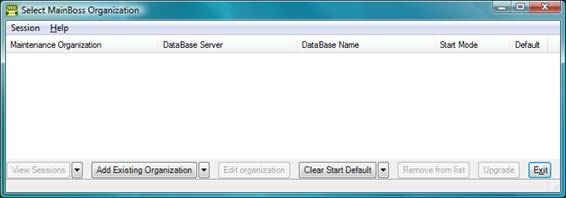
 |
Creating a Maintenance Organization |
This help file applies to an out-of-date version of MainBoss.
The most recent version of MainBoss is MainBoss 4.2.4.
This help file does not exist in MainBoss 4.2.4, but the index for that version can be found here.
< Previous section | Table of Contents | Index | Next section >
When you first start MainBoss, the software displays a window that lets you create a new maintenance organization (database).

In order to create a MainBoss database, you must be logged into an account that has SQL Server Administrator privileges on the SQL Server that will manage the MainBoss database.
Important: MainBoss's language support mostly adapts to the personal preferences of each individual user, as expressed in the user's "Regional Settings". However, a few key terms are generated and stored in the database at the time the database is created. If possible, these terms are translated into the preferred language of the person who creates the database; for example, if the database creator has set "Regional Settings" to English, the key terms will be stored in English. Once this happens, the terms are difficult to change. Therefore, it's important for the person who creates the database to set his or her "Regional Settings" to whatever language will best suit the needs of the whole organization. (Note that you can override your existing "Regional Settings" using the /CultureInfo option on the MainBoss command line. For more, see Command Line Options.)
Changing Regional Settings may also change the currency symbol (e.g. from "$" for dollars to "£" for pounds). However, MainBoss cannot handle multiple currencies; it assumes that all money values are in the same currency. For example, if you enter 33 in a "Unit Cost" field, MainBoss may display the result as $33.00 or £33.00 depending on your Regional Settings...but internally, MainBoss simply record 33.00. Therefore, it is important that all MainBoss users use the same currency for all money values.

< Previous section | Table of Contents | Index | Next section >